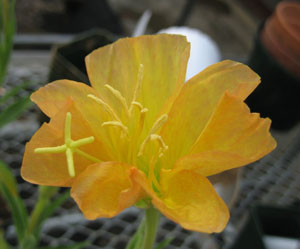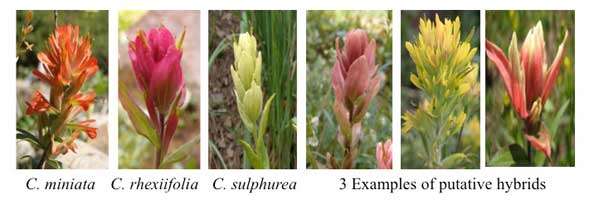Overview of Research in Lab
New research grants seek to better understand:
- Patterns of genetic and phenotypic variation and adaptation - a particular focus is on the fate of ecologically relevant duplicate gene in complex communities.
- The genetic architecture of adaptation in auto- and allo-polyploids, in order to better predict how species distribution might change following climatic/environmental disturbances.
Past and On-going Research
Sex, Genetic Variation, and Adaptation
 Sexual reproduction (recombination and segregation) is thought to confer an advantage over asexual reproduction by strengthening the ability to purge deleterious mutations and increasing adaptive potential. In collaboration with Marc Johnson, I am testing whether such existing theory on the evolution of sex can predict the evolution of plant defenses and other ecologically relevant traits. To test various hypothesis, I am studying sister taxa in the Evening Primrose family (16 asexual and 16 sexual taxa); this group is ideally suited for such research because asexual taxa have arisen multiple, independant times and they have a gentic system which dramitically reduces both recombination and segregation.
Sexual reproduction (recombination and segregation) is thought to confer an advantage over asexual reproduction by strengthening the ability to purge deleterious mutations and increasing adaptive potential. In collaboration with Marc Johnson, I am testing whether such existing theory on the evolution of sex can predict the evolution of plant defenses and other ecologically relevant traits. To test various hypothesis, I am studying sister taxa in the Evening Primrose family (16 asexual and 16 sexual taxa); this group is ideally suited for such research because asexual taxa have arisen multiple, independant times and they have a gentic system which dramitically reduces both recombination and segregation.
Towards this end, I have shown that sexually reproducing lineages have higher rates of positive (adaptive) molecular evolution and higher constituitive expression levels of a basic chitinase gene - a gene that is integrally involved in resistance to pathogens (Hersch-Green et al 2012).
I am now analysing gene sequence data from four genes in the flavonoid biosynthetic pathway – a pathway that plays a pivotal role in plant defense against natural enemies. This data explores how position of a gene in a pathway and sex combine to effect the accumulation of deleterious mutation and adaptive molecular evolution (Hersch-Green et al. in prep). Along with colleagues, I am also analyzing transcriptome data multiple defense genes to test various hypothesis about gene expression and sex.
Hybridization, Polyploidy, and Species Interactions in Indian Paintbrush Species:
Interspecific hybridization and polyploidy play fundamental roles in generating variation that leads to diversification among plant populations and lineages. Whether hybridization and/or polyploidy can account for observed patterns of phenotypic and genetic diversity, in any particular case, requires an investigation of the factors (i.e., extrinsic abiotic, extrinsic biotic and/or intrinsic) that influence plant fitness and the forces that maintain "hybrid zones". I am examining how natural selection, polyploidy and hybridization influence the ecology and evolution of Indian paintbush species (genus Castilleja), hemiparasitic plants that require host plants for optimal performance.
I am examining how natural selection, polyploidy and hybridization influence the ecology and evolution of Indian paintbush species (genus Castilleja), hemiparasitic plants that require host plants for optimal performance.
Various projects include:
- Understanding and Documenting Complex Patterns of Hybridization- Conjectures of hybridization among these species had previously been based upon floral color variation FLORAL COLOR VARIATION. I examined examined multiple sources of data and found that hybridization is occurring but that the majority of "field-classified" hybrids have an unknown and complex ancestral history (Hersch-Green and Cronn, 2009). Current research is using next generation sequencing technology to test hypothesis about the ancestral history of these plants, to look for evidence of genomic rearrangements, and to test various hypothesis about gene and genome duplications.
- Polyploidy and Gene Flow Patterns - A difference in ploidy between mating partners is usually considered one of the most potent reproductive isolating mechanisms, suggesting that polyploidy may influence spatial patterns of gene flow. I performed reciprocal hand pollinations among these species to examine how ploidy influences spatial patterns of gene flow and the ploidy level and subsequent evolutionary trajectories of F1 hybrids (Hersch-Green in revision under review). Additional field studies and next generation sequencing technologies will be used to test the role that polyploidy and genomic rearrangements plays in spatial patterns of gene flow in Indian paintbrushes.
- Biotic (species) interactions- Hybrid and polyploid genotypes often display increased phenotypic and genotypic variation for important ecological traits, which could influence interactions with other species. I have examined how interaction with other species influences selection pressures (e.g., pollinators, Hersch and Roy 2007; foliar herbivores and pathogens, Hersch-Green and Roy in review; seed fungal pathogens and host species, unpublished data).

 and how trait variation influences interactions with pollinators and herbivores (e.g., iridoid glycoside chemistry and herbivory patterns - Hersch-Green and Bowers in prep).
and how trait variation influences interactions with pollinators and herbivores (e.g., iridoid glycoside chemistry and herbivory patterns - Hersch-Green and Bowers in prep).
Genetic Variation and Community/Ecosystem Implications
Genetic variation both (1) among closely related species (due to hybridization and associated introgression) and (2) within a single species can influence the ecology and evolution of dependent organisms and community/ecosystem properties. In collaboration with colleagues (Link text), I am studying trees in the Salicaceae family (Populus species - including aspen, cottonwood, and poplar trees) to test hypothesis about how genetic variation of dominant trees species affects communities and ecosystems.
 (1) Variable Patterns of Hybridization and Introgression: I genetically characterized a hybrid zone in SW Colorado involving 2 Cottonwoods species ( Populus angustifolia and P. deltoides ) to test whether patterns of hybridization and locus-specific introgression vary spatially and temporally among hybrid zones involving similar species (Hersch-Green under review). Eventually I hope to examine how similarity and differences among gene introgression patterns influences the ecology and evolution of dependent community members.
(1) Variable Patterns of Hybridization and Introgression: I genetically characterized a hybrid zone in SW Colorado involving 2 Cottonwoods species ( Populus angustifolia and P. deltoides ) to test whether patterns of hybridization and locus-specific introgression vary spatially and temporally among hybrid zones involving similar species (Hersch-Green under review). Eventually I hope to examine how similarity and differences among gene introgression patterns influences the ecology and evolution of dependent community members.
(2) Genetic variation within Single Species and Restoration: In collaboration with colleagues, I have teamed up to genetically characterize trees in 2 very large restoration gardens in SW USA to test hypothesis about how genetic variation, origin of restoration trees, and planting design, influences restoration projects including the survival of planted trees and the community of native and endangered dependant organisms (Some recent publications: Ferrier et al 2012, Bangert et al 2012 in press). Research in these gardens continue and there is ample room for new projects!